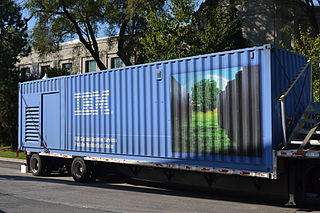
Trend Micro Inc. is a Taiwanese multinational cyber security and defense company with global headquarters in Tokyo, Japan, a R&D center in Taipei, Taiwan, and regional headquarters in Asia, Europe and the Americas. The company develops enterprise security software for servers & cloud computing environments, networks, end points, consumers, and small & medium businesses. Its cloud and virtualization security products provide cloud security for customers of VMware, Amazon AWS, Microsoft Azure, Oracle and vCloud Air.

Google data centers are the large data center facilities Google uses to provide their services, which combine large amounts of digital storage, compute nodes organized in aisles of racks, internal and external networking, environmental controls, and operations software. This article describes the technological infrastructure behind Google's websites as presented in the company's public announcements.

Equinix, Inc. is an American multinational company headquartered in Redwood City, California, that specializes in internet connection and data centers. The company leads in global colocation data center market share, with 200 data centers in 24 countries on five continents.
Urs Hölzle is a Swiss software engineer and technology executive. He is the senior vice president of technical infrastructure and Google Fellow at Google. As Google's eighth employee and its first VP of Engineering, he has shaped much of Google's development processes and infrastructure.
WAN optimization is a collection of techniques for increasing data transfer efficiencies across wide-area networks (WANs). In 2008, the WAN optimization market was estimated to be $1 billion, and was to grow to $4.4 billion by 2014 according to Gartner, a technology research firm. In 2015 Gartner estimated the WAN optimization market to be a $1.1 billion market.

Sun Modular Datacenter is a portable data center built into a standard 20-foot intermodal container manufactured and marketed by Sun Microsystems. An external chiller and power were required for the operation of a Sun MD. A data center of up to 280 servers could be rapidly deployed by shipping the container in a regular way to locations that might not be suitable for a building or another structure, and connecting it to the required infrastructure. Sun stated that the system could be made operational for 1% of the cost of building a traditional data center.
Sun Constellation System is an open petascale computing environment introduced by Sun Microsystems in 2007.
The Google Modular Data Center was a modular data center built from a set of shipping containers, and used by Google to house some of its servers.
Riak is a distributed NoSQL key-value data store that offers high availability, fault tolerance, operational simplicity, and scalability. In addition to the open-source version, it comes in a supported enterprise version and a cloud storage version. Riak implements the principles from Amazon's Dynamo paper with heavy influence from the CAP Theorem. Written in Erlang, Riak has fault tolerant data replication and automatic data distribution across the cluster for performance and resilience.
Wakame-vdc is an IaaS cloud computing framework, facilitating the provisioning and management of a heterogeneous virtualized infrastructure. Wakame-vdc virtualizes the entire data center; servers, storage, and networking. Wakame-vdc is managed via a native Web Interface, the Wakame-vdc CLI, or the powerful Wakame-vdc API.

A modular data center system is a portable method of deploying data center capacity. A modular data center can be placed anywhere data capacity is needed.
CtrlS is a Tier-4 Datacenter in India, headquartered in Hyderabad. It deals with large group of networked computer servers typically used by various organizations for the remote storage, processing, or distribution of large amounts of data. Large groups of remote servers are networked to allow centralized data storage and online access to computer services or resources. CtrlS belongs to the IT industry.
A cloudlet is a mobility-enhanced small-scale cloud datacenter that is located at the edge of the Internet. The main purpose of the cloudlet is supporting resource-intensive and interactive mobile applications by providing powerful computing resources to mobile devices with lower latency. It is a new architectural element that extends today’s cloud computing infrastructure. It represents the middle tier of a 3-tier hierarchy: mobile device - cloudlet - cloud. A cloudlet can be viewed as a data center in a box whose goal is to bring the cloud closer. The cloudlet term was first coined by M. Satyanarayanan, Victor Bahl, Ramón Cáceres, and Nigel Davies, and a prototype implementation is developed by Carnegie Mellon University as a research project. The concept of cloudlet is also known as follow me cloud, and mobile micro-cloud.

A micro data center (MDC) is a smaller or containerized (modular) data center architecture that is designed to solve different sets of problems that take different types of compute workload that does not require traditional facilities. Whereas the size may vary from rack to container, a micro data center may include fewer than 4 servers in a single 19-inch rack. It may come with built-in security systems, cooling systems, and/or fire protection. Typically there are standalone rack-level systems containing all the components of a 'traditional' data center. including in rack cooling, power supply, power backup, security, fire and suppression. They could be rapidly deployed indoors or outdoors or also in rugged terrains.

Epyc is a brand of x86-64 microprocessors designed and marketed by AMD based on the company's Zen microarchitecture specifically targeted for server and embedded system markets. It was introduced in June 2017. Epyc processors share the same microarchitecture as its regular desktop-grade counterparts but have enterprise-graded features such as higher core counts, more PCI Express lanes, support for larger amounts of RAM, and larger cache memory. It also supports multi-chip and dual-socket system configurations through the Infinity fabric interchip interconnect.

Super Micro Computer, Inc, doing business as Supermicro, is an information technology company based in San Jose, California. Supermicro's headquarters are located in Silicon Valley, with a manufacturing space in the Netherlands and a Science and Technology Park in Taiwan.









